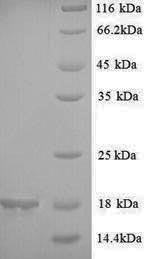The production of this Recombinant Glycine max Musk protein began at the genetic level, where the coding sequence for the Musk protein was first isolated and cloned into an expression plasmid vector. Recombinant DNA technology was used in the process. Next step was cloning. The expression vector must be introduced into the host cell (Yeast) so that the cells could be cultured and expressed the desired 2S albumin protein. And we finally got the recombinant 2S albumin protein with the purity of 90%+ determined by SDS-PAGE.
2S albumins, defined on the basis of their sedimentation coefficient, are a major group of seed storage proteins widely distributed in both mono- and di-cotyledonous plants. As storage proteins, they are deposited in protein bodies of developing seeds and are utilized by the plant as a source of nutrients (amino acids and carbon skeletons) during subsequent germination and seedling growth. Recent findings have demonstrated that 2S albumins can also play a protective role in plants as defensive weapons against fungal attack. In addition to their physiological role in plants, these small globular proteins are becoming of increasing interest in nutritional and clinical studies. The amino acid composition of 2S albumin proteins from many plant species has revealed their high content of sulphur-containing amino acids.






